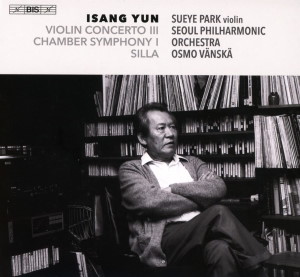
Isang Yun (1917-1995)
Silla – Legend for Orchestra (1992)
Violin Concerto III (1992)
Chamber Symphony I (1987)
Sueye Park (violin)
Seoul Philharmonic Orchestra/Osmo Vänskä
rec. 2021, Lotte Concert Hall, Seoul, South Korea
BIS BIS-2642 SACD [67]
This recording of music by Isang Yun is the second to come my way this year, and hopefully a sign of a greater awareness and recognition of this great Korean musician and composer. It is particularly encouraging that an important European recording label has used South Korea’s leading orchestra to present Yun’s late orchestral works.
Isang Yun lived one of the most tragic careers of any musician; he was imprisoned during the Japanese occupation of Korea in the Second World War and in 1967 he was kidnapped by South Korea’s police in Germany and taken to a prison in Seoul where he was tortured and at one point attempted suicide. Yun’s crime, apparently, was attending concerts in the DPRK (North Korea), where a festival of his music was established. Thankfully he was released from detention following an international campaign which included Igor Stravinsky, Hans Werner Henze and Herbert von Karajan.
Much of his music relates to his formative years in Germany when he collaborated with Europe’s leading avant-garde musicians. ‘For me, composing means seeking and finding mysteries, a land of experiment. From the beginning of the 1960s until the present day, I have never remained in the same place for more than three or four compositions; I have always continued to seek further and further. I now limit myself more and more to what is substantial, in order to transmit more peace, more goodness, more purity and warmth into this world’.
Before the Second World War he studied in Japan, and later in Paris and Germany, where he became influenced by the Darmstadt School. He used European models while trying to discover his own identity; initially, he employed twelve-tone technique, and the aesthetics of the Schoenberg school. International recognition came as he began composing in the post serial style of the avant-garde, writing colourfully fluctuating soundscapes.
The earliest work on this disc is the Chamber Symphony I written for two oboes, two horns and strings which, like all the music on this disc, was composed in his second homeland Germany where it was premiered in 1988. It is in a single movement broken into three parts, combining wind instruments in groups and switching relationships as they oppose or complement each other. As Walter-Wolfgang Sparrer writes in the notes: ‘The basic stance is dialectical in its alternation of appellative passages directed in outward and introverted passages. Developments extending over longer stretches keep breaking off and then begin again in quiet dynamics. Spiral-like forward and upward motion aiming at liberation is a characteristic element.’
At the centre of the symphony is a beautifully tender idea on the strings, ‘Herzschritte’, in which we hear wavering phrases interrupted by fermatas. ‘String flowers’ emerge and embrace glissandi and trill glissandi that create gorgeous sequences and reflect on the composer’s health at the time.
The Legend for Orchestra – Silla echoes the ethnic culture and philosophy of the composer’s homeland, and the foundation of the Korean kingdoms (676-935 AD). Yun’s conception reflects on the tradition of the Hwarang academies that cultivated music and poetry during an era of peaceful enlightenment. The work embraces the magic colours of the night, festivities, dancing, joy and sadness, the changing pictures evoking family and the environment where people meet at home or in the garden.
The Violin Concerto III was a commission by the Holland Festival and premiered by Vera Beths with the Hilversum Radio Philharmonic Orchestra under Hans Vonk on 22 June 1992. It was written in 1992 following hospital treatment in the Black Forest and completed during Yun’s recuperation in the Harz mountains. It marked Isang Yun’s 75th birthday, and he intended it as a gift to his granddaughter (who he hoped would perform it) and a reflection on his musical career. He now felt free from previous influences and had attained a new freedom in his writing. Sparrer writes: ‘This suggests an almost Romantic subjectivisation and individualization of expression, but also devotion to the musical moment.’
There is a lyricism in the music as layers of sound and twinkling two-tone and three-tone motifs emerge with allusions to Korean folk songs; a quotation of a heroic idea is heard on the trumpet and horn in the first section and in the last movement, a military march appears. Again, Sparrer notes that Yun uses ‘tone-colour melody,’ which breaks into fragments given to various instruments. Yun commented on this concerto: ‘Yes, I went flying far with the angels’. The Korean violinist Sueye Park gives a beautiful performance of her compatriot’s final orchestral work, and she is marvellously accompanied by the Seoul Philharmonic Orchestra under the masterly direction of Osmo Vänskä.
The state-of-the-art SACD recording is exceptional; one can hear every group in the orchestra clearly. The disc is enclosed in a paper envelope contained in a gate-fold cardboard cover. The 36-page informative booklet contains notes on the composer by Walter-Wolfgang Sparrer, to whom I am indebted for this review. The texts are in English, German, Korean, and French with black and white photos and biographies of the performers, composer and the orchestra. I am happy to concur with Hubert Culot’s previous review; this is exceptional music and an obligatory release for all disciples of modern music and of this important Korean composer.
Gregor Tassie
Previous review: Hubert Culot (October 2022)
Help us financially by purchasing through





















